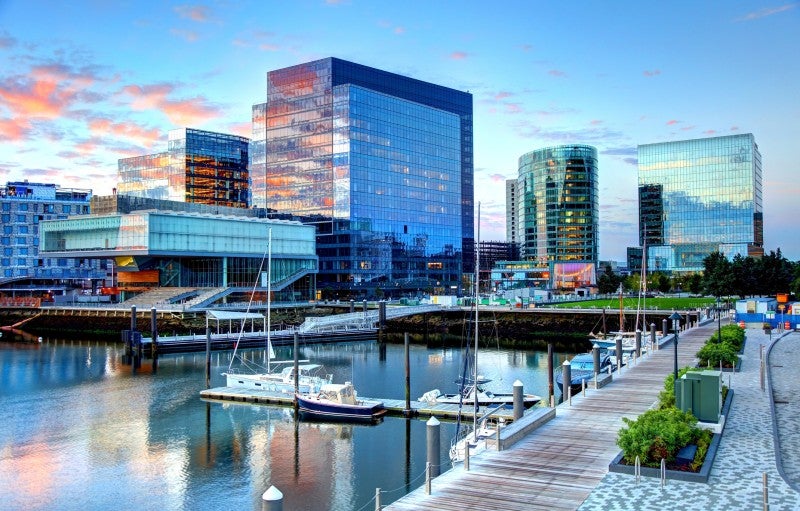As Boston Builds Climate Infrastructure, Developers Are Helping to Pay for It

This article was originally published by the American Planning Association and is reprinted with their permission.
With 47 miles of coastline subject to punishing inundation, Boston is considering a range of innovative techniques to build resilience against the inevitable impacts of climate change. But one of the most groundbreaking features of this effort may well be the mechanism to pay for it.
City officials last year established a Climate Resiliency Fund to help finance the berms, seawalls, and natural systems restoration that will help protect real estate in the vulnerable Seaport district and other potential flooding hotspots. Private developers will make contributions to augment local, state, and federal funding.
The mechanism will be applied to the estimated $124 million cost of protecting a city-run, 191-acre coastal industrial park, but is poised to become a template for building resilience at many other vulnerable areas.
While chipping in to help build defenses seems to be an obvious thing to do, the resiliency fund reflects an important recognition: Public investments in critical infrastructure benefit the private sector by boosting property values—and in the case of rising seas, allow land to continue to be usable.
“There’s been a cultural shift,” said Brian Golden, who retired this spring as director of the Boston Planning and Development Agency after eight years of service. With such a huge task—preparing for 40 inches of sea level rise by 2070 across a landscape of hundreds of acres of squishy landfill dating back to colonial times—developers understand they have to pitch in and foot part of the bill, he said at the Lincoln Institute’s Journalists Forum in April.
“We don’t get a lot of people balking at any of this,” he added, suggesting that developers have come to understand exactions and charges for climate infrastructure as a basic reality of the times, and appreciate the consistency and predictability of the policy. “If you're doing business with us . . . you're going to be paying to build some resiliency measures.”
Don’t ‘Leave Money on the Table’
What’s happening in Boston reflects a growing consensus around the world, rooted in the concept of land value capture: the retrieval of increased land and property values specifically associated with government action and public investment. Just as a new transit line can increase values for properties all along it, resilience infrastructure can be shown to do the same. That increase in value is identified as the land value increment.
Allowing the private sector to enjoy those benefits without making any contribution is increasingly recognized as the equivalent of “leaving money on the table,” noted Enrique Silva, director of International Initiatives at the Lincoln Institute.
Value capture won’t fully finance climate adaptation efforts, but can become part of a “stack” of public finance arrangements that jurisdictions can leverage together, said Lourdes German, executive director of The Public Finance Initiative and a Lincoln Institute board member, also speaking at the Journalists Forum. Drawing contributions from developers and landowners can help fill critical gaps that often remain at the local level, after national and state funding is allocated.
The search for the necessary revenue to fight the battle against climate change, estimated by the UN to be some $90 trillion worldwide through 2030, is certain to intensify. Governments have been using versions of value capture in Brazil, Colombia, Ecuador, the United Kingdom, and throughout Asia for many years. Officials in Miami are studying similar mechanisms to help pay for resilience infrastructure in that flood-prone city.
Protecting Assets
The argument for developer contributions is bolstered by the quality of the climate action efforts, which build confidence that real estate assets on urban land will indeed be protected. Boston has been taking steady steps for decades to address climate change in its planning, backed up by changes to zoning regulations and its broad application of Article 80, which provides the discretion to approve projects with certain strings attached. The Climate Ready Boston plan won an APA award in 2019, and Singapore’s Lee Kuan Yew World City Prize bestowed special recognition for the city’s efforts to address climate change in an older coastal city.
It may have taken the climate crisis for landowners and developers to accept the obvious benefits of such government-funded interventions, said Golden. In the past, public investments that enhanced land and property values may have been regarded as a gift to the private sector or a form of stimulus for economic activity. Now the enormity of the task—fending off the water in some places, letting it be absorbed in others—is clear to all the stakeholders, who are more willing to be part of such a daunting, but necessary, effort.
“It’s an old city, our building stock is fundamentally 19th century and early 20th century, and none of this was considered,” said Golden, referring to climate impacts and flooding. “And it's not just about the benefit to metropolitan Boston. We are, after all, the economic engine of all the New England states. So people are, in 2022, signing up for this. They get it.”
Anthony Flint is a senior fellow at the Lincoln Institute, host of the Land Matters podcast, and a contributing editor to Land Lines.
Image: Boston's Seaport District. Credit: Denis Tangney Jr. via iStock/Getty Images Plus.